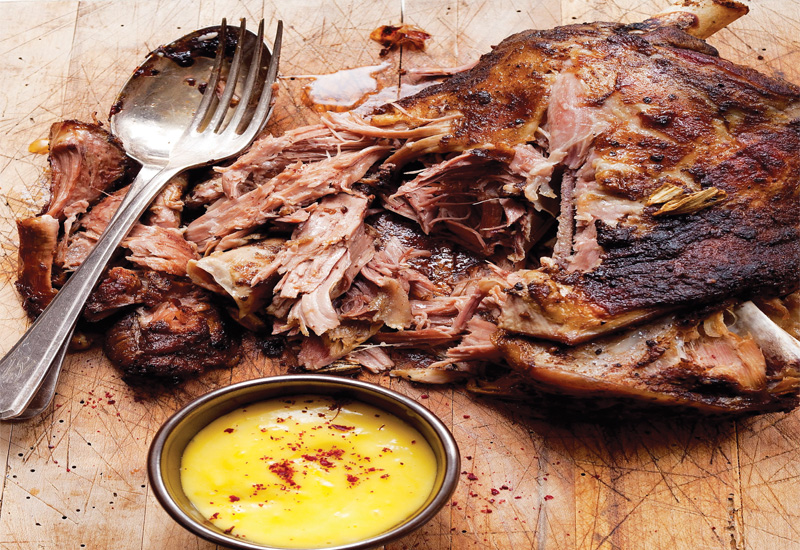 Rowe's dishes are influenced by popular international dishes but given an Ottoman twist which she captured in her book Purple Citrus and Sweet Perfume.
Rowe's dishes are influenced by popular international dishes but given an Ottoman twist which she captured in her book Purple Citrus and Sweet Perfume.
The Dubai dream
“While at Quince I was approached several times to launch a similar concept in Dubai. Dubai for me was the last place on my mind. I found it crass, over the top, bling, arrogant — everything I didn’t like.
At the same time, I knew I would have to get involved in the concept so would have to be there. I refuse to be a named chef — personally it is about presence and enthusiasm.

| Advertisement |
“On top of this I knew it was time for me to move on from Quince. While I loved it and loved my team, for me, just to have the one concept — it wasn’t enough. I want to share my food, I believe in food generosity and feeding lots of people and needed more of a challenge,” says Rowe.
And so she gave Dubai a chance: “The moment we entered Dubai by car I was amazed, I couldn’t believe it. It’s an incredibly vibrant city — I loved it; the buzz, the feel, the culture. I then had a number of meetings and started feeling very positive about Dubai,” she says.
What particularly caught her attention is the focus from operators on investing in new concepts for the city, she says, both in terms of hotels and standalones.
“The operators I am dealing with have worked on some really diverse concepts. People had told me Dubai is the sort of place which has so much money, it is not interested in new concepts, it just sees things in the west, wants to uproot and implant them here and pays serious money for these things.
But for me it’s been really surprising to see people say ‘we like what you do, we’re prepared to partner you and grow it’,” she adds.
So what exactly is the golden idea that investors are desperate to throw their cash at? “The style is Ottoman or mezzaria” reveals Rowe.
Introducing Ottoman
Having been born to a Bulgarian mother and a Turkish father, Rowe’s influences are largely Ottoman inspired. However, her dishes are also inspired by other cultures.
“When I moved to the west, I experienced places like Zuma and Nobu. I love what they do. They use traditional foods and modernise them — put a different spin on them. I knew I could do the same, but with an Ottoman twist.
Zuma does shrimps with white miso, I can do the same with spices and flavours of the Middle East. They do a honey and sake glazed lamb chop, I can do the same with Ottoman spices, crusted and grilled. Basically I combine my heritage with what people enjoy today.”
But while the region, inevitably, is full of Middle Eastern restaurants, Rowe is certain she has something different to add to the mix.
She says that until now there has been significant emphasis here on creating great concepts for French, Japanese, Italian, Indian and Chinese cuisine, but very little focus on a strong Middle East concept — presented as high-end, but accessible to the masses. She sees her restaurant looking like the Wagamama concept.
It seems a little ambitious to me at this point; ‘high-end, yet reasonably priced, different Middle-East food.’ But Rowe’s confidence in her quest has me somewhat convinced the idea will do well. She’s obviously studied the market very carefully and knows exactly who to target and how. One of those sectors — though not limited to — is the health-conscious customer.
“The Middle East has huge rates of diabetes — and when you think back to its cultural staple foods like baklava, it’s no wonder. Baklava is delicious, but let’s face it, it is like eating sponge saturated in butter, it is just no good for you. I do the same, but a healthier alternative. I do a cake, with no butter, no fat, no dairy.
“My food is going to be marketed as a healthy option. My bastilla and pastry are steamed for example. I don’t use oil — I heavily rely on spice and herb blends — I have about 10 different zaatars, such as black truffle zaatar for the most elevated of dishes, grapefruit zaatar, blood orange zaatar. For the salad dressing, I use very little olive oil. It’s mainly based on homemade molasses — mulberry; cherry; date; pomegranate, instead of balsamic vinegars.”
Article continues on next page ...








 Search our database of more than 2,700 industry companies
Search our database of more than 2,700 industry companies









